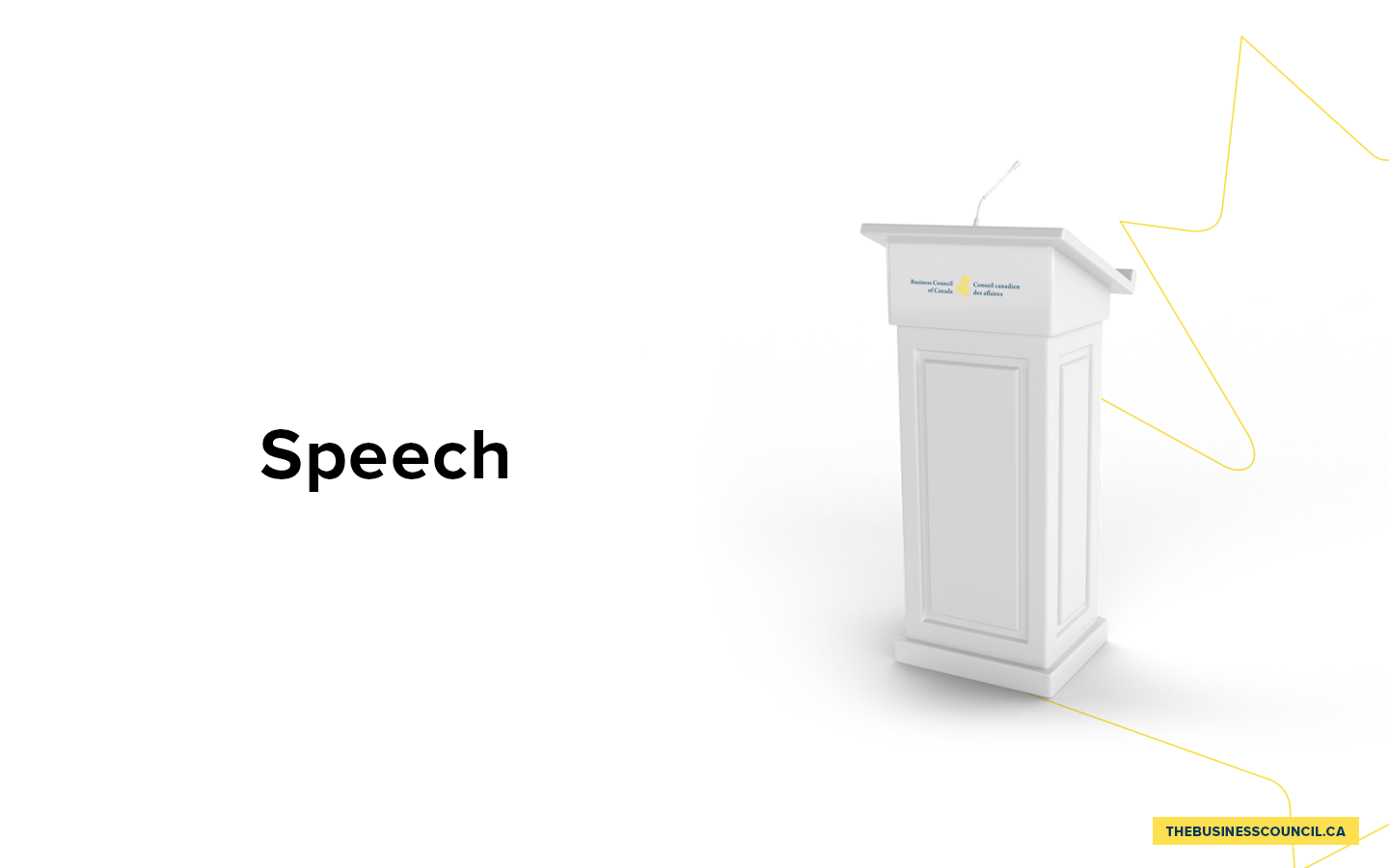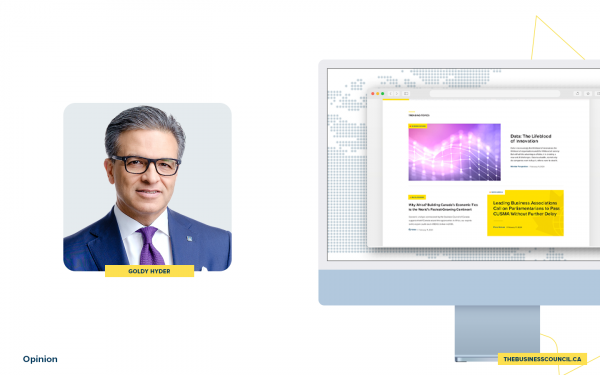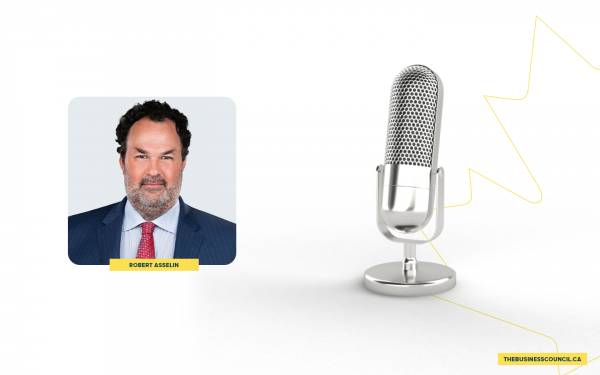2022 Thomas d’Aquino lecture on leadership
Goldy Hyder delivered the Ivey Business School’s Thomas d’Aquino Lecture on Leadership in London, Ontario on October 3,2022 and in Ottawa on November 7, 2022
Good evening.
It is an honour for me to be here to deliver this year’s Thomas d’Aquino Lecture on Leadership.
I can think of no better person to have a lecture on leadership named in their honour than Tom – who, as my predecessor, built the Business Council of Canada into the force it is today.

I use the term ‘built’ intentionally, because it is at the heart of my very succinct and straightforward definition of leadership.
Just four simple words: leadership is about building.
It’s so basic a definition you might even consider it a statement of the obvious. But it encompasses many things.
Successful leaders are builders of trust, of connections, of great organizations and winning cultures.
Leaders build up the people around them, so that together the organizations they lead can solve problems efficiently and innovate with agility and vision
Leaders build powerful, engaged teams. They build relationships, movements, and coalitions.
Building is how leaders lead.
In terms of Canada’s economic security there are many different types of ‘building’ I could talk about in the context of competitiveness and productivity.
I could talk about the need for us to build a better innovation ecosystem for research and development.
I could talk about the need to build a stronger manufacturing sector to produce more Canadian-made goods.
I could talk about the need to build a competitive tax system to attract investment.
All these topics deserve and demand their own lectures.
But, today, I want to talk to you about a more literal and critical kind of building.
I’m talking about building things, physical things: major nation-building projects that unite us as a country.
Specifically, large economic infrastructure projects such as highways and bridges, ports and pipelines, rail terminals and electricity grids, wind, and solar power systems.
Export-enabling infrastructure projects that cross multiple jurisdictions and generate well-paying jobs in different parts of the country not just during construction, but for years to come.
We are a trading country, always have been, but there are real questions today about whether we can get goods to market.
Canadians used to be great at building these things.
The country we know today – the modern, advanced economy that provides Canadians with a high quality of life and is a magnet for people from around the world – it wouldn’t exist if it hadn’t been for leaders who thought big and built even bigger.
Think of the Trans-Canada Highway, which was built between 1949 and 1962.
When completed, it was the longest uninterrupted highway in the world, spanning almost 7,500 km from the Atlantic Ocean to the Pacific and passing through all 10 provinces of Canada.
Think of the St. Lawrence Seaway, one of the world’s most heavily used international trade routes.
When the Seaway opened in 1959, it represented the final link in a waterway almost 3800 km long, from the westernmost point of Lake Superior to the Gulf of St. Lawrence.
Think of the TransCanada pipeline, known today as the Canadian Mainline. It also belongs on this list.
Constructed in the 1950s to deliver natural gas from Western Canada to Ontario and Quebec, it had the distinction of being the longest pipeline in the world until the 1980s.
All three of these projects were built during the post-war period – mainly in the 1950s.
It’s also no coincidence that the 1950s marked the beginning of the greatest economic boom in Canadian history.
Massive infrastructure projects made possible by a dramatic increase of capital investment meant jobs and higher living standards for workers and families.
In January 1953, Time Magazine took note of Canada’s rising prosperity in an article headlined, “Rosy Picture.”
With a population of only 14.5 million, the American magazine observed Canada had a per capita GDP second only to the U.S.
In that same year, Time reported, more than 5 billion dollars had been poured into new industry and capital investment.
Today, economists describe the 1950s as the “golden age” of public and private infrastructure investment in Canada.
But here’s where the narrative changes.
It’s as though, during the decades which followed, we decided that we no longer needed to focus so much on nation-building projects and economic infrastructure.
Today, to the extent that we talk about infrastructure at all, most of the discussion is about social infrastructure:
A national childcare program, affordable housing, health care and other initiatives that improve social equity and enhance Canadians’ quality of life.
To be clear, these sorts of initiatives aren’t just important – they’re vital.
They’re an essential part of building the Canada we want today and for future generations.
But we will not be able to afford them without reliable physical infrastructure –without the roads, bridges, ports, pipelines, generating stations, and electrical grids which generate the wealth that pays for the social infrastructure we rely on and value so highly.
We need physical infrastructure to connect supply chains, enable people and goods to move freely, support millions of jobs, and ensure that our economy continues to grow.
Again, leaders must be builders.
So, what’s the problem?
Do businesses lack the know-how and capability to build big projects?
Nope.
On the contrary, in each of the sectors I’ve just named, Canada boasts world-class, innovative companies with deep experience here and in other markets around the world.
For example, TC Energy recently announced that it is working to help build a 4.5 billion dollar Southeast Gateway Pipeline in Mexico.
Is the problem that businesses aren’t able to build coalitions within communities?
Wrong again.
Canadian companies recognize the need for meaningful engagement with Indigenous communities whose people and traditional territories stand to be impacted by major projects.
This goes beyond employment and training to long-term revenue-sharing agreements, business partnerships, and equity ownership of the project itself.
We have come a long way.
In September, Hydro One announced an industry-leading equity partnership model with First Nations across Ontario.
Going forward, Hydro One will offer First Nations a 50 per cent equity in all large-scale capital transmission line projects – those with a value exceeding 100 million dollars.
As Hydro One explained this “will transform the benefits of infrastructure development for First Nations communities for generations to come.”
This initiative was in addition to Hydro One’s commitment that it was increasing its Indigenous procurement spend to 5 per cent of all materials and services by 2026.
They are not alone.
In late September, one of our members – Enbridge – sold equity stakes in seven of its pipelines to Indigenous communities in the Athabasca region of Northern Alberta.
These types of initiatives are examples of how responsible development can help advance reconciliation.
If the problem isn’t the capability to build big, or a lack of community partnerships – is it a lack of investment capital?
No! Not that either.
In fact, our country’s large institutional investors have been pioneers in global infrastructure investing since the 1990s.
I’m speaking here about the
- Canada Pension Plan Investment Board,
- Caisse de dépôt et placement du Québec,
- Ontario Municipal Employees Retirement System (OMERS),
- and other large provincial public sector pension funds.
Collectively these funds have participated in some of the largest infrastructure investments in the world in recent years.
They own major stakes in highways in India, ports in the U.S. and the U.K., water and sanitation utilities in Latin America, and power transmission grids in Europe and Australia.
If you talk to any of them, they will say they would love to invest in similar projects here in Canada, but there aren’t enough opportunities.
It’s simply harder to build big projects in Canada than it is when you go abroad.
And that’s our problem!
Simply put, we have made it far too difficult to build things in Canada.
It takes too long and costs too much.
Consequently, leaders who want to build are almost forced to look elsewhere for investment opportunities with lower perceived risk and a more welcoming attitude.
This is hardly a national secret. A 2018 report by the World Bank ranked Canada 32 out of 33 OECD countries based on the time it takes to get a simple commercial building permit.
It’s a statistic that has been quoted widely, and for good reason.
It’s consistent with the everyday experience of companies and entrepreneurs in the energy, transportation, telecom, residential real estate, mining, and agri-food sectors.
Unfortunately, there is now far too much uncertainty in the approvals process.
You all know the star-crossed tale of the Trans Mountain pipeline expansion.
Designed to deliver crude and refined oil from Edmonton to Burnaby, B.C., the original pipeline was constructed over an 18-month period in 1952 and 1953, at a cost of 93 million dollars.
In 2013 the pipeline’s owner, Kinder Morgan, filed an application with the National Energy Board to build a second, parallel pipeline to meet the rising demand for Canadian energy in Asian markets.
As of 2015, the cost was estimated at 5.4 billion dollars.
A year later, the federal cabinet approved the twinning project, subject to 157 conditions.
The following year the Province of British Columbia gave its consent … while imposing an additional 37 conditions.
Still, Kinder Morgan had the green light to proceed … but that all changed in a few months.
Later in 2017, a new provincial government took office and reversed the approval, vowing to fight the project all the way to the Supreme Court of Canada.
And on and on it went.
In 2018, Kinder Morgan lost patience with the political wrangling and put the project up for sale.
With so much uncertainty surrounding the project, no private investors were willing to step in.
Instead, the Government of Canada bought it for 4.5 billion dollars.
To date, the seemingly endless regulatory hurdles, permitting delays, environmental concessions and court actions have driven up the expansion’s cost from 5.4 to 21.4 billion dollars.
It’s hard to build something when the rules keep changing, so we need consistency.
We also need to strike a more sensible balance.
For example, in April 2021 workers discovered a single hummingbird’s nest in a tree that had been cut down on the pipeline’s right-of-way.
Even though that species, the Anna’s hummingbird, is not endangered – and thousands of other nests had already been moved or protected – regulators ordered a halt to construction.
Any guesses how long that shutdown lasted?
Four months and it reportedly added 100 million dollars to the cost of the project.
By the time the Trans Mountain Expansion is completed in late 2023, the final price tag will be at least four times the original estimate.
That’s more than it needed to be, but at least it’s getting built!
I’m even more concerned about the major projects that DON’T get built in this country.
In August, the Chancellor of Germany, Olaf Scholz, came to Canada with a delegation of senior German business leaders.
Germany is facing severe energy shortages caused by Vladimir Putin’s attack on Ukraine and his decision to cut off exports of Russian natural gas.
Facing a dire crisis, the Germans hoped we would help them offset their reliance on Russian energy by building liquefied natural gas (LNG) export infrastructure in Atlantic Canada.
With LNG export infrastructure in place, Germany could import the energy they desperately needed from Canada – a like-minded country which shares their values.
But when they got here, the federal government said no – they weren’t sure there was a sufficient business case to build it.
They even tried to suggest the Germans weren’t really that interested in LNG.
Two weeks later, Germany’s largest importer of natural gas signed a 16-year contract to purchase LNG from an export terminal in Australia.
Then, a week after that, Chancellor Scholz visited the United Arab Emirates and signed another agreement to buy LNG from the UAE in the immediate term.
Did Canada blow an opportunity? Absolutely.
Instead of showing leadership – instead of building the infrastructure that’s required to take advantage of Canada’s abundant energy supplies – we sat on our hands.
Worse, we turned our backs on our friends.
Sadly, this was not an isolated incident.
When I visited Korea in May, a senior government official accused Canada of ‘hoarding’ our resources – keeping them to ourselves for our own benefit to the detriment of our allies.
They couldn’t conceive of the possibility that the real reason was we can’t get our act together to build the export infrastructure required to get our resources to market.
They told me that their inability to import energy and critical minerals from Canada was preventing them from living their values.
They were forced instead to import energy and critical minerals from totalitarian governments which don’t share their values.
Make no mistake, this is not simply about letting down our allies – as bad as that is.
We’re letting ourselves down.
This is a Canadian problem.
When Canadians no longer believe our large institutions can build things – I’m talking both businesses and governments – they lose trust and confidence in those institutions.

I worry today that our country risks being pulled apart by increased regionalism, polarization, and inequity as are so many other developed countries around the world.
Done properly, nation-building projects can be a thread that sews the country back together.
They can be a tie that binds us – as the railroads, and highways, and power grids did for the generations before us.
To that end, I’ve repeatedly urged government to designate certain energy and critical mineral projects as being in the national interest and to establish expedited approval processes.
At a minimum, I would argue, there should be expedited reviews for projects which lead Canada towards decarbonization – that should be a no-brainer
Many of us were encouraged when, in August, the Prime Minister said he was open to easing processes to allow certain major projects to move through regulatory hurdles more quickly.
Our expectations were heightened when Deputy Prime Minister Freeland said in Washington that Canada must – and will – fast-track certain types of energy and critical mineral projects.
And, when Natural Resources Minister Wilkinson said, “it is clearly the case in this country that we need to find pathways to develop projects more rapidly than we have in the past.”
However, in November’s Fall Economic Statement, all the government committed to was an investment to hire more people at our environmental assessment and permitting agencies.
It is a step in the right direction – but we’re still walking when we need to run.
Time is of the essence – we need to start building today.
Let me repeat: Leadership is about building.
And that leads me to my call to action.
In her Washington speech Chrystia Freeland said we must be “prepared to spend domestic political capital in the name of economic security.”
By that she means we can’t please all of the people all of the time – but we need to do the right thing even when it might not be popular.
I know all of us in this room are seized with ensuring Canada’s economic security.
I know all of us understand that economic security is linked to environmental security.
I have long said environmental security and economic security are not either/or propositions – they are one and the same.
Extreme weather caused by climate change is a clear and present danger to economic security.
We have witnessed what happens when electricity grids are knocked out and hundreds of thousands of Canadians are left without power for days on end.
We have seen the disruption to trade caused when major rail and roadways are washed out by floods or closed due to massive forest fires.
We need infrastructure that is resilient to the worst that comes our way including hurricanes, floods, tornados, and fires.
Extreme weather is caused by climate change.
Climate change is driven by greenhouse gas emissions.
Canada’s business leaders understand this, which is why they have developed clear emissions reduction plans and invested billions of dollars to implement them, and why we have supported a carbon tax since 2007.
Still, while we take essential steps to reduce greenhouse gas emissions, we must also develop an adaptation plan to address the extreme weather occurring today.
Of course, there is a third type of security – energy security.
And energy security means energy transition.
The world may need oil and gas for decades to come, but the shift to renewables is well-underway and certain to accelerate.
The result is huge demand for critical minerals such as lithium, graphite, nickel, cobalt, copper, and rare-earth elements – the building blocks of the green and digital economy.
Canada has these in abundance, often in remote locations.
Our major allies and trading partners are lining up to partner with us but we must first construct roads and rail lines, develop mines, and build processing facilities.
It’s hard work, but it can be done.
This is a generational opportunity for Canada – we can’t be the generation that squanders it.
To realize this opportunity we need major, game-changing, nation-building projects that will only be built if our private and public sectors work together.
The economic potential is huge, but the rest of world will not sit around waiting. We need to act now.
Canada needs leadership to build in these and many other areas.
We need expanded ports and modern transportation infrastructure to trade with the rest of the world.
We need cutting-edge digital infrastructure that enables Canadians to push the boundaries in everything from artificial intelligence to automation, the Internet-of-things, the metaverse, quantum computing, and augmented reality.
We need an estimated 5.8 million new homes by the end of this decade, according to Canada Mortgage and Housing, to meet the anticipated growth in our country’s population and enable better matching of households with the housing they need and can afford.
We need to build out Canada’s electrical vehicle charging infrastructure along highways and where Canadians live, work and play, to support EV adoption and the goal of a net-zero future.
We need to at least double the production of electricity in Canada as we replace many uses of fossil fuels with clean electricity.
We need all of these, and much more, for Canada to achieve its potential, and for future generations of Canadians to enjoy the high quality of life they deserve.
I’m an optimist, but nation-building doesn’t happen by itself.
It requires leadership.
The leadership to imagine.
The leadership to plan.
And the leadership to build.
Thank you.











